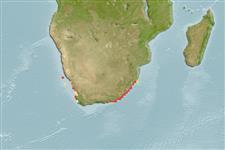Common names from other countries
Environment: milieu / climate zone / depth range / distribution range
Ecologia
marinhas; estuarina demersal; intervalo de profundidade 10 - ? m. Subtropical; 28°S - 34°S
Southeast Atlantic: Mossel Bay to Natal in South Africa.
Length at first maturity / Tamanho / Peso / Idade
Maturity: Lm 57.5 range ? - 70 cm
Max length : 200 cm TL macho/indeterminado; (Ref. 3198); common length : 100.0 cm TL macho/indeterminado; (Ref. 3507); peso máx. Publicado: 80.0 kg (Ref. 4537)
Descrição breve
Chaves de identificação | Morfologia | Morfometria
Espinhos dorsais (total) : 11; Raios dorsais moles (total) : 10 - 11; Espinhos anais: 3; Raios anais moles: 8. Reddish, bronzy or golden-yellow in color; young with a blotch behind dorsal fin.
Found near rocky banks in coastal waters including estuaries. Adults solitary and territorial. Feeds on octopus, crabs and fish, especially Spondyliosoma. The flesh is highly esteemed, but the liver is poisonous due to high vitamin A content which causes hypervitaminosis. Popular angling fish. Largest of the porgies.
Life cycle and mating behavior
Maturities | Reprodução | Spawnings | Egg(s) | Fecundities | Larvas
Smith, J.L.B. and M.M. Smith, 1986. Sparidae. p. 580-594. In M.M. Smith and P.C. Heemstra (eds.) Smiths' sea fishes. Springer-Verlag, Berlin. (Ref. 3198)
Categoria na Lista Vermelha da IUCN (Ref. 130435)
CITES (Ref. 128078)
Not Evaluated
Ameaça para o homem
Poisonous to eat (Ref. 3507)
Utilização humana
Pescarias: pouco comercial; peixe desportivo: sim
Ferramentas
Relatórios especiais
Descarregue XML
Fontes da internet
Estimates based on models
Preferred temperature (Ref.
115969): 15 - 24, mean 22.2 (based on 10 cells).
Phylogenetic diversity index (Ref.
82804): PD
50 = 1.0000 [Uniqueness, from 0.5 = low to 2.0 = high].
Bayesian length-weight: a=0.01549 (0.00889 - 0.02698), b=3.04 (2.89 - 3.19), in cm Total Length, based on LWR estimates for this species & (Sub)family-body (Ref.
93245).
Nível Trófico (Ref.
69278): 4.5 ±0.61 se; based on food items.
Resiliência (Ref.
120179): Baixo, tempo mínimo de duplicação da população 4,5 - 14 anos (K=0.08; tm=5-7; tmax=30;).
Fishing Vulnerability (Ref.
59153): Very high vulnerability (80 of 100).
Climate Vulnerability (Ref.
125649): Very high vulnerability (92 of 100).
